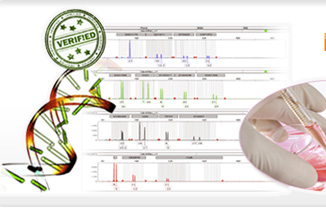
|

|

|
Cell line contamination has been plaguing researchers since the beginning of the
discipline.1
Only recently has technology caught up to the problem and provided precise and affordable
preventative measures. Even a few years ago, this problem was still going unidentified
in even the most esteemed publications:
|

|
|
|
|
|
|
|

|
|
|

|
The prestigious breast cancer cell line MCF-7/AdrR were distributed by the National
Cancer Institute (NCI) due to their resistance to many different drugs in the NCI-60
panel. This cell line was used in many studies of breast cancer cells, and in 2000,
were found to be ovarian cancer cells and not breast cancer cells at all. Liscovitch
and Rabin, who uncovered this fiasco, estimate that there are perhaps 300 published
studies that relied upon this misidentified cell line.1,2
|
|

|
|
|
|
|
|
|
|
|
|
|

|
|
|

|
In 2009, a team of researchers from the University of California, San Francisco
led by Osamu Tetsu found that several adenoid cystic carcinoma cell lines, ACC2,
ACC3, ACCM, ACCNS, ACCS, and CAC2, which had all been widely used in research, had
been misidentified or contaminated at different times. As of 2010, all six are still
in use.3
|
|

|
|
|
|
|
|
|
|
|
|
|
The scientific community first learned about the problem of cell line contamination
over forty years ago, when methods of detection were limited to slow and expensive
processes, such as karyotyping and the identification of biochemical polymorphisms.
Even the advent of DNA fingerprinting in the 1990s did not provide a practical and
cost-effective solution.
|
|
|
|
|
|
|
|
“We are fortunate that STR technology is available,” says Dr. Miguel
Castro, CEO of Bio-Synthesis, Inc., who goes on to say that Bio-Synthesis's own
affordable STR technology can “unequivocally” identify cell lines and
contain cross contamination potentially making cell line contamination a thing of
the past.
|
|
|
|
|
|
|
|
The ATCC and increasing numbers of journals, notably Biotechniques, Cancer Research,
and In Vitro Cellular and Developmental Biology now require authentication on all
cell lines used in studies submitted for publication. Nature requires STR data on
human embryonic stem cell lines.4 The FDA is even more strict, requiring cell
line authentication as a condition of drug approval.5
|
|
|
|
|
|
|
|

|

|
Bio-Synthesis is pleased to offer an affordable cell line authentication service
that goes above and beyond the requirements of the above organizations, providing
customers with a complete package of precision and convenience.
|

|
|
|
|
|
|
|
Bio-Synthesis's cell line authentication service uses 16 markers in total to identify
cross-contamination among human cells. The proprietary methods used by Bio-Synthesis
can detect interspecies contamination between pigs, human, cats, Chinese hamsters,
Rhesus monkeys, sheep, horses, African green monkeys, rats, dogs, mice, rabbits,
goats and cows. Customers can expect turnaround in 4-5 days, with a 48-hour rush
service available upon request.
|
|
|

|
|
|
|
|

|
|
|

|
|

|
|




